Y-12 Blog
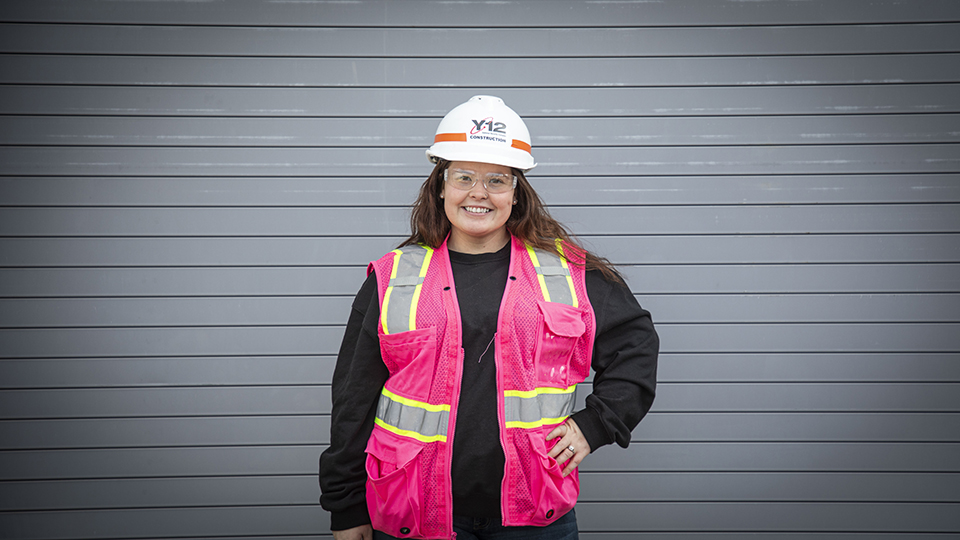
Construction Trainer Megan S. shares her thoughts on teamwork as part of a series of Y‑12 stories highlighting our Construction team. Photo by Matthew Hawkins.
The Y‑12er spotlight shines on one of our own, Megan S., Y‑12 Construction Trainer. It takes all Y‑12 employees to make the mission happen successfully and safely. All views and opinions are the employee’s own and do not necessarily reflect those of CNS.
Megan S. enjoyed school so much that she wanted to find a way to bring teaching to her day job. While her path landed her as a laborer at Y‑12, Megan imagined how she would share her knowledge and inspire others the way her instructors inspired her.
“The teachers that I had encouraged me to be my best, and I always wanted to give the same,” she said.
That dream became a reality for her when she became a Construction trainer at Y‑12, providing training that the Construction team needs for field work.
“Now I train people with the knowledge that I have and have the opportunity to teach and encourage people to be their best the same way I was taught,” she said.
Megan teaches qualification requirements on Mondays and manages dress‑outs (a practice run of what employees would encounter in a radiological area) on Tuesdays through Thursdays. She also schedules classes, inputs key data, completes documentation checklists, and more to ensure employees receive the training and credits needed to perform daily tasks. Additionally, she manages the computer lab and runs reports for craft and subcontractors. Her favorite part of the job, though, is interacting with the on‑site team.
“I love talking to people, meeting new people, and just getting to know someone’s background and how they got here,” she said.
What stands out to you about Y‑12?
This place is like a little town; there’s so much opportunity at this place — a lot of opportunities to grow and better yourself.
What has surprised you during your time at Y‑12?
One thing that has surprised me at Y‑12 is there is never a day that goes by that you don’t learn something new. You truly learn new things every single day!
What is one thing your coworkers would be surprised to know about you?
The one thing my coworkers would be surprised to know is my family owns Wartburg Speedway. We have owned it for 7 – 8 years now, but racing has always been in my family, about 26 years. My father has raced for as long as I’ve lived, street stock and late model. My dad and I would tear motors apart, wash the race cars, and then he would have me WD‑40 the whole car to make it “shiny.”
Who in your life has inspired you the most and why?
The person who has inspired me the most is my mother. She taught me to be a hard worker and to never depend on anyone. She has always told me if I put my mind to something, to go full force. She had lung cancer when I was a freshman in high school and has been in remission ever since. She’s taught me how to be strong and always told me to never give up on a dream. I always put my all into whatever I am doing because my mom told me if I wanted anything, I’d have to work for it. I hope when it’s my time to be a mother, I’ll be just as great!”
Give an example of how teamwork has helped your role.
Teamwork is an important aspect of Y‑12. If the team doesn’t work together, nothing is going to get done. In my role, teamwork is understanding and listening to what other people have to say, and everyone comes together into a group and figures out the problem.
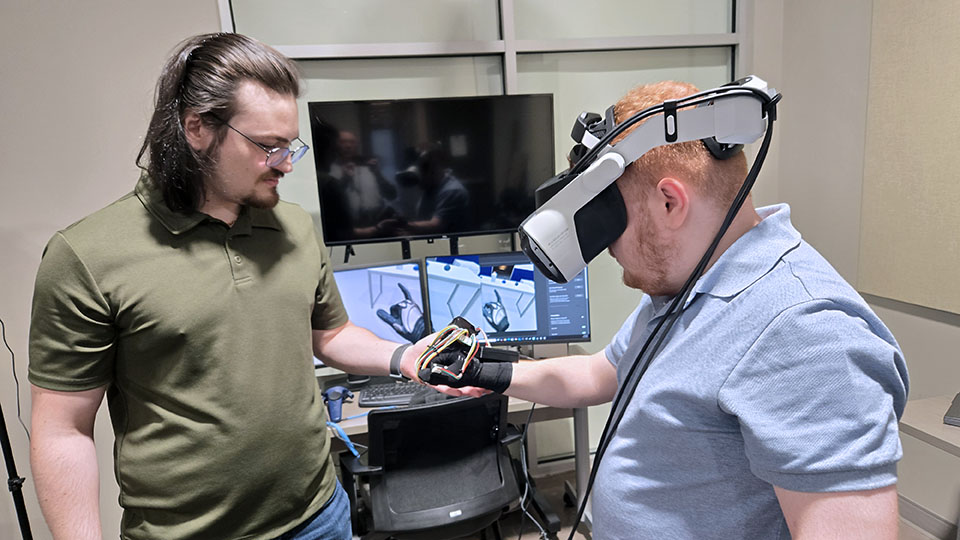
FIU graduate students Julian Guerra (L) and Brad Alvarez manipulate a haptic glove
On February 17, a Florida International University (FIU) graduate student, Brad Alvarez, placed a device called a haptic glove onto his hand and worked the glove’s fingers, remotely manipulating a robotic hand from a short distance away.
This small demonstration, conducted at the Oak Ridge Enhanced Technology and Training Center (ORETTC), drew a round of applause and big smiles from the observers surrounding Alvarez.
Among them was ORETTC Director Ashley Stowe because he saw the potential this glove could bring Y‑12.
“We use haptic gloves as a training tool in a virtual reality environment,” Stowe said. “They allow workers to do hazardous work training without actually being in a hazardous environment.”
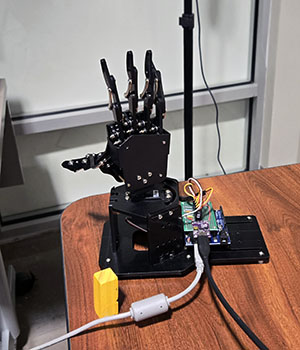
Robotic hand connected remotely to haptic glove. (Photo by Gene Patterson.)
This advancement, Stowe explained, takes hazardous work safety a step further, allowing trained workers to be removed from the hazard while controlling robots in the hazard area to accomplish a task.
“Potentially, this could have a huge impact on how we do work at Y‑12,” Stowe said.
The technology is being developed in partnership with Florida International University. Dr. Shekhar Bhansali heads the program, assisted by Research Scientist Dr. Vivek Kamat.
“We’ve worked with Y‑12 for the past 4 ½ years, and it’s been a great benefit for our students and for Y‑12,” Bhansali said. “It allows us to advance new technologies while training our students in real‑world settings and helps us place students on a career path.”
Those career paths can take the students in many directions. Working with both software and hardware is a big reason FIU students enjoy their time in Oak Ridge.
“We want students involved in this program who are serious about the work,” Kamat added. “These students start from scratch to work a problem, develop a design, and create something new and innovative.”
One of those “serious” students is Miami Native Julian Guerra. He arrived at ORETTC in September 2024 as a co‑op student funded through the Minority Serving Institution Partnership Program (MSIPP). Cooperative education programs, similar to internships, allow students to alternate between academic studies and real‑world practical experiences.
“The partnership with FIU is a shining example of how the MSIPP program can produce top‑tier talents that are uniquely qualified to impact the Y‑12 mission,” Y‑12 Workforce Program Advisor Sanchez Harley said.
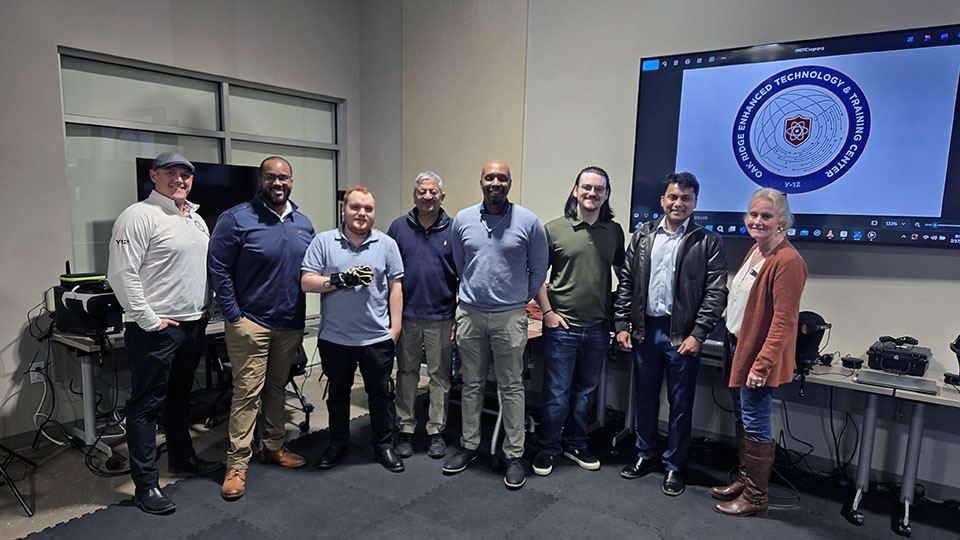
ORETTC and FIU partners: (from left) ORETTC Director Ashley Stowe, ORETTC’s Austin Arnwine, FIU Student Brad Alvarez, FIU Instructor Dr. Shekhar Bhansali, CNS Workforce Program Advisor Sanchez Harley, FIU Student Julian Guerra, FIU Researcher Dr. Vivek Kamat, and ORETTC’s Mary Lin. (Photo by Gene Patterson.)
Stowe agrees. “Universities, like FIU, are a vital part of our forward‑looking instructional technology research,” he said. “We, government labs, have a tendency to fall into a standard way of thinking based on our strict regulatory environment. Professors and students bring creativity to our landscape and a different way of thinking.”
Stowe said Guerra has integrated quickly and easily with the ORETTC team and described his work ethic and attitude as “fantastic.”
Guerra says his experience in Oak Ridge has been “more than expected.”
“When I arrived at ORETTC, I would say my knowledge was mostly theoretical, based on coursework and research. My hands‑on experience was limited,” Guerra said.
In just a few short months, that has changed.
“ORETTC has given me a better understanding of what it’s like to work in a rapidly developing industry,” Guerra said. He added the experience was beneficial for him in several ways, including growing skills through hands‑on experiences, collaborating with skilled professionals and subject matter experts, and, most importantly, contributing meaningfully to projects.
“I get to work in a lot of different areas. There’s so much to do. It’s like playing with toys, except in this case, we’re creating really cool stuff,” Guerra added.
Stowe said a benefit from students like Guerra coming and working at Y‑12 is their ability to see problems from a different perspective, allowing industry professionals to be led to new areas — like the haptic glove interface with a robot, which Stowe believes is just the beginning of technology that’s to come.
“These are very bright students who are up on the latest technologies,” Stowe said. “We want to tap into that knowledge base and help them help us. It’s a win‑win.”
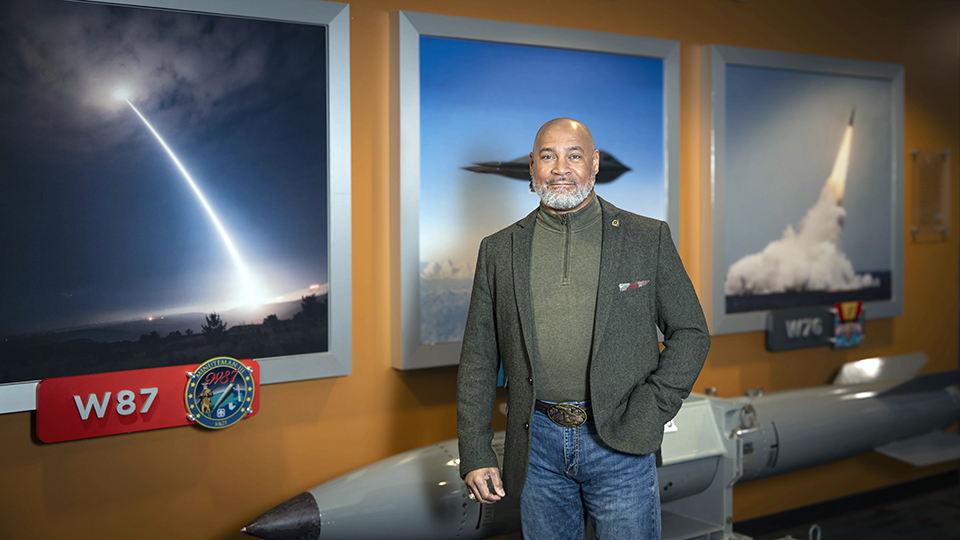
After almost 30 years of military service and a stint at Pantex, Chris Burns is now ready to serve at Y-12. Photo by Matthew Harkins.
The Y‑12er spotlight details one of our own, Chris Burns, vice president of Safeguards, Security, and Emergency Services. It takes all Y‑12 employees to make the mission happen successfully and safely. All views and opinions are the employee’s own and do not necessarily reflect those of CNS.
Chris Burns is not new to Consolidated Nuclear Security. He was the senior director of Safeguards and Security at the Pantex Plant and has now moved from Texas to Tennessee to serve as vice president of Safeguards, Security, and Emergency Services (SS&ES).
Prior to joining CNS, Burns served almost 30 years in the Army, retiring as a colonel. During his time in the military, he held various command and non‑command roles, including deputy Provost Marshal General of the U.S. Army, director of Army Inspections, commander of both the 759th Military Police Battalion and 42nd Military Police Brigade, and director of emergency services for Joint Base Lewis‑McChord.
Despite his military experience, Burns said he didn’t know anything about DOE and NNSA. However, when he was preparing to retire, David Turner (vice president of Operations Support and a fellow Army retiree) suggested he look into the work at Pantex and Y‑12.
“When I read the duty description, I got really excited,” said Burns. “The facilities are central to the security of our nation.”
Burns understands that employees interacting with SS&ES may not be having their best day. #&8220;As a whole, we have to be at our best when we come to work every day; so, we’ll be at our best when you may be at your worst.”
What excites you about your new role?
I am most excited to have the opportunity to help shape the future of Y‑12. The site is evolving, and Safeguards, Security, and Emergency Services (SS&ES) has to evolve as well. Change is hard for most, but working with true professionals here at Y‑12, especially in SS&ES, makes change a bit easier to swallow.
Share your history prior to joining CNS.
I served in the military for almost 30 years, with multiple combat tours between Iraq and Afghanistan, not to mention a few other places, but my transition out of uniform and into civilian life was well supported by both the Army and CNS. My first 14 months as a civilian were spent as the senior director of Safeguards and Security at the Pantex Plant. It was a tremendous opportunity, and I learned a lot about the company, NNSA., and the DOE. For me, the mission and the people were a good fit!
What knowledge/history do you have of Y‑12?
When I was transitioning out of the military, I didn’t know anything about DOE/NNSA. What I did know was a bit about the Manhattan Project, but I didn’t know a piece of that history resided right here at Y‑12.
What top strength do you bring to your organization and why?
I think I bring calmness, along with a fresh set of eyes. I don’t get overly excited, which is a skill set I bring from the U.S. Army. You have to be that calm voice in the midst of crisis or problem‑solving. Having a fresh set of eyes allows me to see things from a different angle and allows me to provide potential solutions or recommendations that aren’t limited or constrained from being in the environment for an extended period of time.
What role do communications play in your job?
Communications play a critical role in how we communicate security changes or critical events. Often, people don’t want SS&ES around until they need us. Why? Because we are inconvenience and delays. We want to move from that reactive response model to a more proactive one that requires us to be a teach-and-train organization. That type of organization requires strong communications. We also want to interface better with our teammates and build more depth to our security programs. For example, take the division security officer program. The Y‑12 Division Security Officer (DSO) program is designed to ensure Safeguards and Security (with an emphasis on Information Security) is intricately entwined with each Y‑12 organization and its operational needs through a centralized representative or group of representatives. These organizational DSOs, in essence, become an extension of Safeguards and Security by providing each organization a conduit through which security needs, awareness, challenges, and overall compliance can be funneled. Their importance, if used correctly, can be widespread and provide a huge impact to each organization, security, and site mission deliverables/challenges.
Why is teamwork an important aspect when working at Y‑12?
There’s no “I” in team. Teamwork is the essence or cornerstone of any organization. All leaders are responsible for building their team. Effective teamwork requires collaboration, communication, trust, and respect. It also emphasizes the importance of shared commitment and diverse perspectives.
Why is it important that we hold ourselves accountable in our daily tasks?
If we’re not accountable, nothing gets done. Accountability is one of 16 traits that a leader must possess in order to be successful. Most folks are self‑critical and recognize that we are responsible for what does or does not happen in our daily tasks. Accountability allows you to take responsibility for your own actions and decisions, and it builds trust with the people around you. It’s easy to see the benefits of personal accountability. Whether you’re the CEO or just starting an entry‑level position, your team members will know that you’re reliable and can be counted on.
What advice would you give a newer employee about the importance of solving problems and asking questions?
When it comes to solving problems, it is important to make sure you define what the problem actually is before you try to solve it. You can waste a lot of energy when the problem is not properly defined, so make sure you’re focusing on the right problem.
It’s also important to listen and ask questions. A good leader can guide a team by asking the right questions at the right time. There’s definitely an art and a science to it.
What’s your top bucket list item and why?
My wife and I want to visit every NFL and MLB stadium. We’re both sports fans, but it’s more than that — it’s about making the memories.
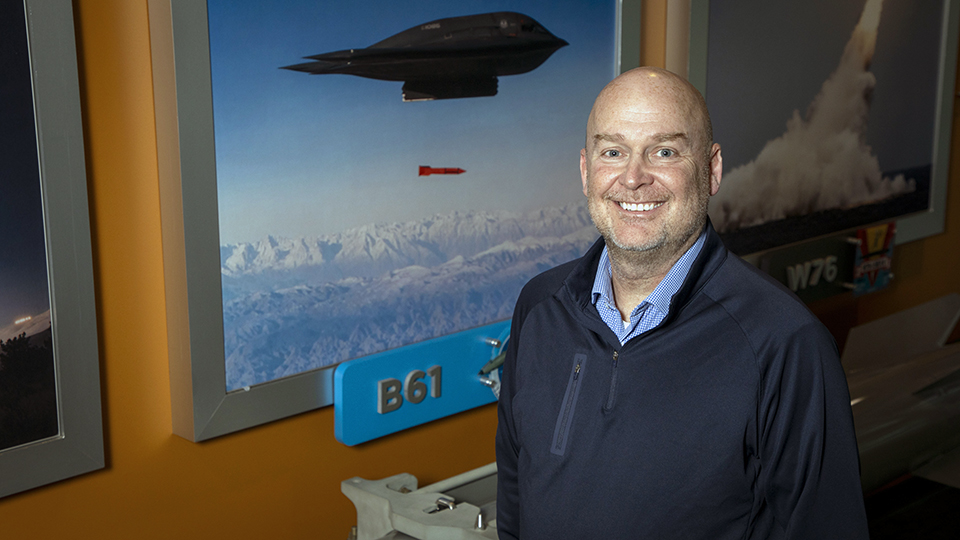
After 20+ years at Pantex, Josh Gerken is ready to make Y-12 his work home. Photo by Joy Kimbrough.
The Y‑12er spotlight shines on one of our own, Josh Gerken, the vice president of Program Integration. It takes all Y‑12 employees to make the mission happen successfully and safely. All views and opinions are the employee’s own and do not necessarily reflect those of CNS.
His is a name and face many Y‑12ers know from his efforts on the Pantex and Y‑12 contract transition during 2024. Now this former Pantexan is a Y‑12er. Get acquainted with Josh Gerken, vice president of Program Integration.
“Until contract transition, I was a career‑long Pantex employee,” Gerken said. “I started at the site in 2001 as a technician in the Gas Analysis Laboratory and have been extremely blessed with opportunities in both technical and leadership roles that support NNSA’s important mission.”
The decision to join Y‑12 wasn’t one Gerken made easily, as it meant leaving behind his family, his roots, and his colleagues. “I miss my Pantex group as I worked with them for 20 years, but I have no worries about developing similar bonds here. Your work relationships and network are important.”
His new role does reach back to the Pantex network, which continues to enhance the Pantex and Y‑12 partnership. “I served as the senior director of Stockpile Programs at CNS for about 2 years until we made the smart decision to divide this role into site‑specific responsibilities,” he said. “I was able to learn a fair amount about the weapons scope at Y‑12; however, given the large size of that scope, as well as the important role that the Oak Ridge Corridor has played and continues to play in our country’s history, I realize that I have so much more to learn.”
And learning is something he does regularly. “I have had team members in the past jokingly tell me I ask too many questions, but asking questions can help me and others learn or view a situation through a new lens.”
His technical experience is an advantage in his role. “I bring a relatively strong technical background to the team, as well as a fresh set of eyes,” Gerken said. “I hope I can bring that perspective, as well as the continued relationships with the site, to Y‑12.”
Gerken sees his role at Y‑12 as a “good trade because I get to see the background and get involved earlier in the process. The pride at Y‑12 and historical legacy of the Manhattan Project that people embrace is really cool. During my time here, I’ve not met anyone who views working here as just a job.”
How can communications make (or break) a task being worked?
Often, without communication, a problem can snowball to where the solution becomes much more complicated. Communications with colleagues, leadership, and customers is vital to ensuring solutions get identified and worked at the appropriate level.
How has teamwork allowed you to grow as an employee?
It has made me realize how dependent we all are on each other, whether as a work group, a site, or an enterprise. Our mission is far too complex to depend on any sole entity. When I realized this and the aperture was opened, it amplified my pride in our mission.
How do our established procedures, administrative controls, rules, etc. help us in being accountable to CNS, our site, and our peers?
Our procedures and policies are what allow us to come to work, deliver on NNSA’s mission with high quality, and go home safely every day. Practicing disciplined operations and never settling underpin CNS’s ability to deliver on such an important mission.
What is the top lesson you have learned by applying problem‑solving skills to an issue?
Do not be afraid to ask for help. There is likely always someone that is going to know more or has more experience in an area who can help with a higher quality solution than going alone.
If you are new to the area, what is something you are looking forward to doing?
We are looking forward to becoming part of the East Tennessee community. The decision to move here was not taken lightly, as all of my family is in Texas, but this was an amazing opportunity with CNS that was too good to pass on. Personally, I have always wanted to live near the mountains, and now that I do, I suppose I should take advantage of all of the activities that the area has to offer!
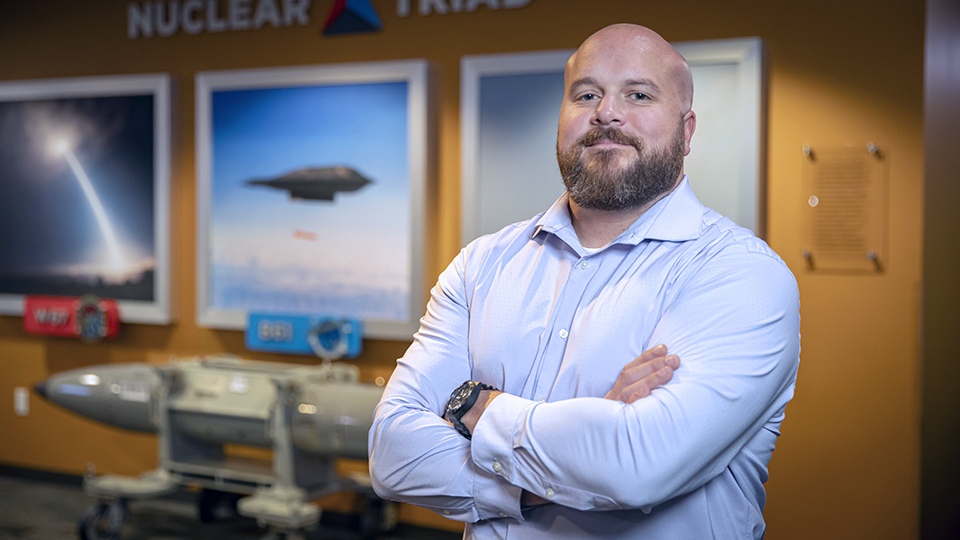
Meet Jon Ragan who is a new member of the Business Management and Transformation leadership team. Photo by Jordan Ray.
Learn about Jon Ragan, the new deputy for Business Management and Transformation. It takes all Y‑12 employees to make the mission happen successfully and safely. All views and opinions are the employee’s own and do not necessarily reflect those of Consolidated Nuclear Security (CNS).
Jon Ragan joined CNS in September, and since that time, he has been driven to learn the ropes of work he calls “challenging, complex, and important.” Ragan was the vice president and deputy general manager of National Aerospace Solutions, LLC, which held the test operations and sustainment contract at the U.S. Air Force’s Arnold Engineering Development Complex (AEDC). At AEDC, he was responsible for Business Operations, which included Project Controls, Supply Chain, Information Systems and Technology, Finance, Human Resources, and Office and Administrative Services, as well as Performance Assurance, which included Safety, Quality, Training, and Continuous Improvement.
“I’m amazed at the complexity of the work that takes place at Y‑12,” Ragan said. “What stands out to me since joining the team is that many of the challenges are quite similar to what I experienced in my last job. While AEDC was smaller in scale and is not the nation’s premier national security complex, we had the same culture of mission and nation first, and similar to Y‑12, we faced challenges with aging infrastructure and tight national security timelines. I’ve also been very impressed with the high level of talent here and commitment to the mission by those I work with.”
He’s not one to stay quiet as he said, “Ask questions. Lots of questions. There is a lot to learn from everyone here.”
Ragan is the deputy for Business Management and Transformation where he oversees key business management tasks and improving processes within the organization. As a first assignment, he’s developing and implementing a digital transformation (DT) structure for Y‑12.
“We have several great working groups and many smart people executing DT‑type projects,” he said. “There is a lot going on in this space, so we need a centralized approach. With help from others, I am creating a Master Integrated Project Team that enables a prioritized and coordinated approach for DT efforts across Y‑12, one that keeps us aligned with all stakeholders and the NNSA DT efforts. This structure will provide the ability to plan and integrate project activities across the Y‑12 organizations and working groups, increase focus on priority efforts that support our requirements, improve disciplined operations and operational efficiencies, and act as an integrator for digital transformation across the site. I have been working closely with our Chief Technology Officer (CTO), and once this structure is stood up, I’ll hand the reigns to him along with the digital transformation program manager. But, because this is near and dear to my heart, I will definitely stay involved.”
During Ragan’s 19‑year career with Bechtel, he has dealt with designing and constructing launch infrastructure to destroying chemical weapons to testing weapons systems. Before he worked at AEDC, he spent 9 years in “chem‑demil” as the deputy business manager for Bechtel’s Blue Grass Chemical Agent‑Destruction Pilot Plant and assistant project manager and business manager for Bechtel’s Pueblo Chemical Agent‑Destruction Pilot Plant.
“Throughout my career, I’ve known the importance of the work we do at Y‑12, and I am very proud to now be on the ground and part of it. Now that I am a part of the team, it has reinforced my thoughts on the importance of the CNS and Y‑12 mission.”
What advice do you offer someone who has made a mistake in his or her job? How should they be accountable for that issue?
Mistakes are not necessarily bad. I like to look at them as learning opportunities; if you make a mistake, own up to it, and make sure you learn from it. When I make a mistake, I take some time to think through what went wrong and figure out how I can do better next time a similar situation arises.
What daily task lets you know you’re helping achieve the CNS mission? How/why does that task let you know you’re working toward the mission?
I see Business Management and Transformation as an enabler to the mission. If I can help to improve a process or processes by implementing change that enables our workforce to more efficiently and effectively support the mission or reduce unnecessary steps (and associated distractions) from a business process, I feel I’m working toward the mission.
What top strength do you bring to your organization and why?
I think it would be persistence and resourcefulness. I like a good challenge and I will find the right information and get the right people involved to resolve it.
Why is teamwork an important aspect when working at Y‑12?
The work here is so important and complex; it takes the best of everyone to achieve the mission. Teamwork is key. At Y‑12, we have production workers to Ph.D. scientists to accountants, to name a few. Everyone’s job is important, and everyone brings a different background and input that contribute to the success we have here.
What’s your favorite outside‑of‑work activity and why?
I enjoy spending time with my family, working on old cars, and barbequing. I have an old Jeep I like to take out on trails. While I haven’t made it to any local trails since I’ve been in the area, it’s definitely on my list.
